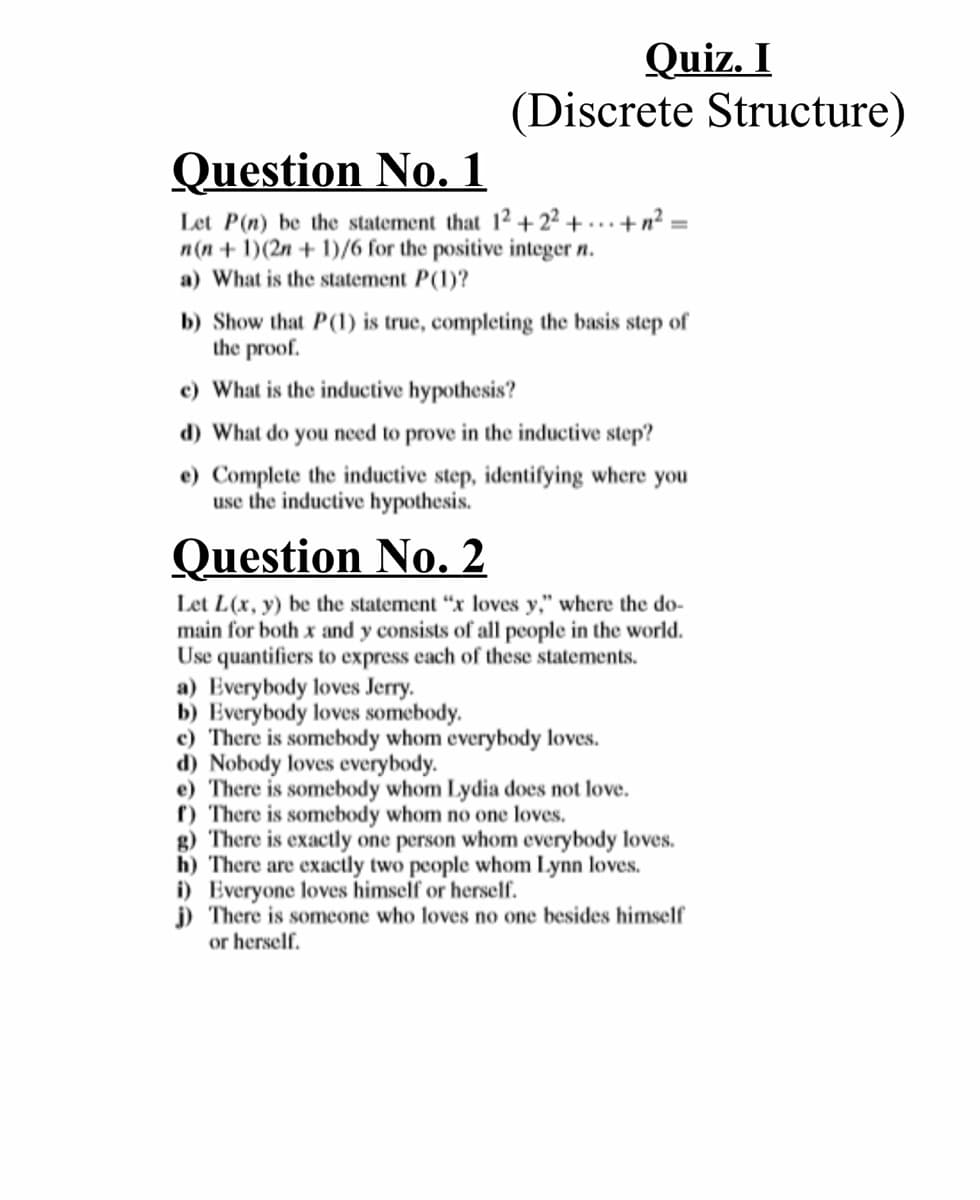(Discrete Structure) Question No. 1 Let P(n) be the statement that 12 +2² + . . .+ n² = n(n + 1)(2n + 1)/6 for the positive integer n. a) What is the statement P(1)? b) Show that P(1) is true, completing the basis step of the proof. c) What is the inductive hypothesis? d) What do you need to prove in the inductive step? e) Complete the inductive step, identifying where you use the inductive hypothesis. Question No. 2 Let L(x, y) be the statement "x loves y." where the do- main for both x and y consists of all people in the world. Use quantifiers to express each of these statements. a) Everybody loves Jerry. b) Everybody loves somebody. c) There is somebody whom everybody loves. d) Nobody loves everybody. e) There is somebody whom Lydia does not love. f) There is somebody whom no one loves. g) There is exactly one person whom everybody loves. h) There are exactly two people whom Lynn loves. i) Everyone loves himself or herself. j) There is someone who loves no one besides himself or herself.
(Discrete Structure) Question No. 1 Let P(n) be the statement that 12 +2² + . . .+ n² = n(n + 1)(2n + 1)/6 for the positive integer n. a) What is the statement P(1)? b) Show that P(1) is true, completing the basis step of the proof. c) What is the inductive hypothesis? d) What do you need to prove in the inductive step? e) Complete the inductive step, identifying where you use the inductive hypothesis. Question No. 2 Let L(x, y) be the statement "x loves y." where the do- main for both x and y consists of all people in the world. Use quantifiers to express each of these statements. a) Everybody loves Jerry. b) Everybody loves somebody. c) There is somebody whom everybody loves. d) Nobody loves everybody. e) There is somebody whom Lydia does not love. f) There is somebody whom no one loves. g) There is exactly one person whom everybody loves. h) There are exactly two people whom Lynn loves. i) Everyone loves himself or herself. j) There is someone who loves no one besides himself or herself.
Algebra & Trigonometry with Analytic Geometry
13th Edition
ISBN:9781133382119
Author:Swokowski
Publisher:Swokowski
Chapter10: Sequences, Series, And Probability
Section10.4: Mathematical Induction
Problem 42E
Related questions
Question

Transcribed Image Text:Quiz. I
(Discrete Structure)
Question No. 1
Let P(n) be the statement that 1² + 2² + · ..+ n² =
n(n + 1)(2n + 1)/6 for the positive integer n.
a) What is the statement P(1)?
b) Show that P(1) is true, completing the basis step of
the proof.
c) What is the inductive hypothesis?
d) What do you nced to prove in the inductive step?
e) Complete the inductive step, identifying where
use the inductive hypothesis.
you
Question No. 2
Let L(x, y) be the statement "x loves y," where the do-
main for both x and y consists of all people in the world.
Use quantifiers to express each of these statements.
a) Everybody loves Jerry.
b) Everybody loves somebody.
c) There is somebody whom everybody loves.
d) Nobody loves everybody.
e) There is somebody whom Lydia does not love.
f) There is somebody whom no one loves.
g) There is exactly one person whom everybody loves.
h) There are exactly two people whom Lynn loves.
i) Everyone loves himself or herself.
j) There is someone who loves no one besides himself
or herself.
Expert Solution
This question has been solved!
Explore an expertly crafted, step-by-step solution for a thorough understanding of key concepts.
This is a popular solution!
Trending now
This is a popular solution!
Step by step
Solved in 5 steps

Recommended textbooks for you

Algebra & Trigonometry with Analytic Geometry
Algebra
ISBN:
9781133382119
Author:
Swokowski
Publisher:
Cengage

Elements Of Modern Algebra
Algebra
ISBN:
9781285463230
Author:
Gilbert, Linda, Jimmie
Publisher:
Cengage Learning,


Algebra & Trigonometry with Analytic Geometry
Algebra
ISBN:
9781133382119
Author:
Swokowski
Publisher:
Cengage

Elements Of Modern Algebra
Algebra
ISBN:
9781285463230
Author:
Gilbert, Linda, Jimmie
Publisher:
Cengage Learning,


College Algebra
Algebra
ISBN:
9781305115545
Author:
James Stewart, Lothar Redlin, Saleem Watson
Publisher:
Cengage Learning